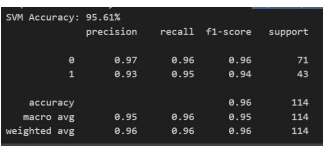
Downloads
Keywords:
Breast Cancer Detection Using Machine Learning
Authors
Abstract
In today's Breast cancer detection becomes more accurate through the use of machine learning algorithms, which examine complex patterns found in patient data. The early diagnosis that these models provide could lead to better patient outcomes and prompt actions. The goal of this study paper is to increase the accuracy and efficiency of diagnostic processes by presenting a thorough investigation of the use of machine learning approaches for breast cancer diagnosis. We investigate how well Support Vector Machines (SVM), Random Forest, and Neural Networks differentiate between benign and malignant cases using a variety of datasets. To improve the discriminatory strength of our models, we also incorporate sophisticated feature extraction methods like the Wavelet Transform and Gabor Filter. The outcomes of the experiment show the promise of various machine learning techniques, with SVM showing a noteworthy accuracy rate. In addition, the research adds to our understanding of decision-making processes by offering insights into how interpretable the models are. Our research highlights the importance of using machine learning to detect breast cancer, providing a viable path forward for improving early diagnosis and treatment planning that follows.
Keywords—Breast cancer, Machine Learning, Accuracy, Efficiency, Support Vector Machines (SVM), Random Forest, Neural Networks, Feature Extraction, Wavelet Transform, Gabor Filter, Interpretability, Early Diagnosis, Treatment Planning.
Article Details
Published
Issue
Section
License

This work is licensed under a Creative Commons Attribution-NonCommercial-ShareAlike 4.0 International License.

